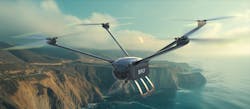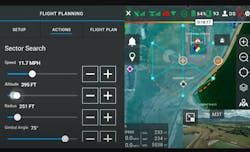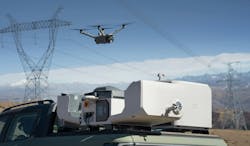Drones for the Fire Service: No Longer Flying Under the Radar
The fire service is making strides with technological advancements, from the utilization of artificial intelligence to all-electric apparatus. One can add to the list recent developments with drones, the software that’s within them and charging/docking stations.
Better decision-making
The extent of fire department drone programs varies. Some departments have fleets that are employed in multiple ways, some have a single drone in the station, and some have no idea where to begin. In play with all of this are the hoops to jump through to get a drone serviceable, including government regulations, waivers and training, but drone companies are helping there, too.
Regardless, the adoption of drones can make processes quicker and better. More-informed decisions can be made. The results: increased safety of potential victims as well as the first responders.
Some departments and experts argue that the full integration of drones within the fire service is imminent, and according to Skydio Public Safety Customer Success Center Manager Jason LaFond, who is a captain for the Katonah, NY, Fire Department (KFD), all it takes is one drone to start.
“Many fire departments think you must be a big agency to have a drone program,” LaFond tells Firehouse. “That’s just not true. You can get tons of value from having one drone. Don’t let perfection be the enemy. Starting a program doesn’t have to be this crazy thing.”
Obstacle avoidance
Firehouse reached out to 17 drone manufacturers to get a lay of the land in regard to fire service-oriented design and usage. Multiple manufacturers informed us that the evolution of unmanned aerial vehicles (UAVs), or drones, is continual.
Skydio’s X10 drone, for example, provides immediate live-streaming capabilities and obstacle-avoidance cameras. The latter creates a so-called illumination bubble around the drone so that the vehicle can avoid hinderances and hazards. This gives it the capability to fly under bridges and through other GPS-denied environments.
LaFond states that most of the folks who are in the fire service, with some basic training, can pick up Skydio’s systems and safely and effectively fly them at a wide variety of different use cases.
Another X10 feature is the capability to take 3D scans. It can model environments in cases of preplanning, incident planning and cause-of-origin for fire investigations via photogrammetry. LaFond has utilized this numerous times for the KFD.
“If we have a structure fire, I’ll model the environment,” he explains. “We’ll use that as a training tool for apparatus placement. Did they leave room for the ladder truck? Did other apparatus block the scene? We’ll map it, and when they break down, we’ll map it again. You create these virtual environments of these real fire scenes.”
SiFly’s new Q12 drone will hit the market at the end of 2025. The idea behind the Q12, according to SiFly Chief Business Officer Logan Jones, is the start of development of a drone to take the place of a light helicopter.
“For us, the benchmark on a single charge for hover or flight that we wanted to hit is over two hours, and we’re between two and three hours in both those flight modes,” Jones states.
When it comes to lifting, the Q12’s capacity is 10 lbs. The next version will be capable of lifting 250 lbs. This ties to disk loading, or the ratio of weight to the total rotor disk area. The lower that is, the more efficiently lifting occurs. This aims toward the drones being capable of delivering compressed foam, mixing agents and water to a fire.
Jones cites wildfires as an example for delivery of water as an alternative to super tankers and the huge amount of capacity that they carry. “You get one shot to dump it, and you must be precise,” Jones says. “Then, you must go back with that single unit and refill.”
SiFly believes that the future is more of an in-and-out process using drones. “You might get 30 gallons or 50 gallons at a time, but you can be super precise,” Jones continues. “You can get much closer to the area, and you can spot spray and attack [the fire] with the right amount of material.”
Software: The nitty gritty
As innovative as the aforementioned drones and others are from a physical standpoint, what makes drones run, what holds everything together, is their software.
The development of BRINC Drones’ LiveOps software began shortly after the mass shooting in Las Vegas in 2018. The auto-updated system is run from the cloud and an internet browser, so no controller is required. 4G enables the UAV to live stream immediately.
The vertically integrated software is a part of BRINC’s unified drone operations program. The software allows the original development of indoor drones to expand to outdoor models
BRINC’s David Benowitz says that, typically, an indoor drone has a separate software than an outdoor drone has. “LiveOps is our attempt to show we’re making all this hardware ourselves. Let’s build this software element that’s both unified across all these products and integrated down to the core of the hardware,” Benowitz explains.
Two-way communication is another strength that LiveOps provides on scene. You can call the drone virtually to communicate through it from an indoor capacity to an outdoor capacity.
DroneSense’s Sector Search software was adopted from the company’s custom search and rescue automation and the U.S. Coast Guard’s search and rescue vector technique. After coordinates for a search area are entered, the drone autonomously scans that area in a bike wheel pattern to reference different angles and different views. DroneSense’s Mike Mocerino explains what that allows first responders to do: “The operator can just focus on visuals and look for whatever might have been last seen on that person, as opposed to flying the aircraft itself.”
FDNY has worked with DroneSense for five years. Fred Carlson, who is the department’s lieutenant of robotics, tells Firehouse that work includes evaluating how Sector Search can be leveraged with FEMA rescue teams. He says the capability for delivering a common
operating picture for supervisors has been a huge help.
“Everything gets put into the in-house application that we built for the department,” Carlson says. “Every fire truck, every chief, has an iPhone or a tablet that can access this, and it sends all the videos to anyone that needs it.”
Docking stations
An element of drone operation that might be overlooked is the drone dock, whether located in a fixed position or portably. Sean Ameche, who is a training captain and UAS program manager at the Ventura County, CA, Fire Department, says the VCFD is in discussions with drone maker DJI to add the company’s Dock 3 for its fleet of 17 drones. Ameche explains that docks would accelerate his team member’s ability to provide aerial situational awareness. “We’re not getting drone operators [to emergency scenes] quick enough,” he says.
Putting docks on top of fire stations even could play into drone as first responder (DFR) operations DJI’s Dock 3 is a charging and deployment station that can be placed in the back of a pickup. It can operate in a temperature range of -22–122 degrees Fahrenheit.
DJI’s Wayne Baker, who is a former Texas fire chief, believes that drones can provide what departments might not have the resources for otherwise.
“A drone is a great force multiplier for fire departments that don’t always have the luxury of having extra people in key positions, like a safety officer,” he says. “You can have that drone operating as your safety and accountability officer. I did as a fire chief and incident commander.”
Drones are here to stay
The concept of drones might be considered complex on first blush by many first responders. However, it’s something that can be taken one step at a time.
SiFly’s Jones believes that an initial lack of understanding of how drones are deployed by public safety groups is a real limitation on adoption.
FDNY’s Carlson adds, “Make sure it fits with your organizational structure … and is in a place that it can be utilized [to provide] the most efficient capabilities for supporting a whole department.”
About the Author

Ryan Baker
Ryan Baker is a writer and associate editor with prior experiences in online and print production. Ryan is an associate editor for Firehouse with a master's degree in sciences of communication from the University of Wisconsin-Whitewater. He recently completed a year of teaching Intro to Public Speaking at UW-Whitewater, as part of his graduate program. Ryan acquired his bachelor's degree in journalism in 2023 from UW-Whitewater, and operates currently out of Minneapolis, MN. Baker, also writes freelances for the Ultimate Frisbee Association (UFA) in his free time, while also umpiring baseball for various ages across the Twin Cities Metro Area.




